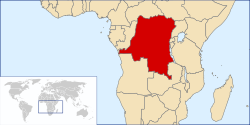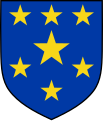Republic of the Congo (Léopoldville)
Republic of the Congo (1960–1964) République du Congo Democratic Republic of the Congo (1964–1971) République démocratique du Congo | |||||||||
|---|---|---|---|---|---|---|---|---|---|
| 1960–1971 | |||||||||
| Motto: "Justice – Paix – Travail" (French) "Justice – Peace – Work" | |||||||||
| Anthem: Debout Congolais (French) Arise, Congolese | |||||||||
 | |||||||||
| Capital | Kinshasa (named Léopoldville before 1966) | ||||||||
| Common languages | |||||||||
| Demonym(s) | Léopoldville-Congolese (1960–1966) Kinshasa-Congolese (1966–1971) | ||||||||
| Government | Federal parliamentary republic (1960–1964) Unitary parliamentary republic (1964–1965)
| ||||||||
| President | |||||||||
• 1960–1965 | Joseph Kasa-Vubu | ||||||||
• 1965–1971 | Joseph-Desiré Mobutu | ||||||||
| Prime Minister | |||||||||
• 1960 | Patrice Lumumba | ||||||||
• 1960, 1961 | Joseph Iléo | ||||||||
• 1961–1964 | Cyrille Adoula | ||||||||
• 1964–1965 | Moïse Tshombe | ||||||||
• 1965 | Évariste Kimba | ||||||||
• 1965–1966 | Léonard Mulamba | ||||||||
| Historical era | Cold War | ||||||||
| 30 June 1960 | |||||||||
| 30 December 1961 | |||||||||
| 16 January 1962 | |||||||||
| 15 January 1963 | |||||||||
• Country renamed DRC | 1 August 1964 | ||||||||
| 25 November 1965 | |||||||||
| 27 October 1971 | |||||||||
| Currency | Congolese franc (until 1967) Congolese zaire (1967–1971) | ||||||||
| ISO 3166 code | CG | ||||||||
| |||||||||
| Today part of | Democratic Republic of the Congo | ||||||||
| History of the Democratic Republic of the Congo | ||||||||||||||||
|---|---|---|---|---|---|---|---|---|---|---|---|---|---|---|---|---|
 | ||||||||||||||||
|
||||||||||||||||
|
||||||||||||||||
|
||||||||||||||||
| See also: Years | ||||||||||||||||
|
| ||||||||||||||||

The Republic of the Congo (French: République du Congo) was a sovereign state in Central Africa, created with the independence of the Belgian Congo in 1960. From 1960 to 1966, the country was also known as Congo-Léopoldville (after its capital) to distinguish it from its northwestern neighbor, which is also called the Republic of the Congo, alternatively known as "Congo-Brazzaville". In 1964, the state's official name was changed to the Democratic Republic of the Congo,[2][3] but the two countries continued to be distinguished by their capitals; with the renaming of Léopoldville as Kinshasa in 1966, it became also known as Congo-Kinshasa. After Joseph Désiré Mobutu, commander-in-chief of the national army, seized control of the government in 1965, the Democratic Republic of the Congo became the Republic of Zaire in 1971. It would again become the Democratic Republic of the Congo in 1997. The period between 1960 and 1964 is referred to as the First Congolese Republic.
Colonial rule
[edit]Conditions in the Congo improved following the Belgian government's takeover in 1908 of the Congo Free State, which had been a personal possession of the Belgian king. Some Bantu languages were taught in primary schools, a rare occurrence in colonial education. Colonial doctors greatly reduced the spread of African trypanosomiasis, commonly known as sleeping sickness.
During World War II, the small Congolese army achieved several victories against the Italians in East Africa. The Belgian Congo, which was also rich in uranium deposits, supplied the uranium that was used by the United States to build the atomic weapons that were used in the bombings of Hiroshima and Nagasaki in August 1945.
The colonial administration implemented a variety of economic reforms to improve infrastructure: railways, ports, roads, mines, plantations and industrial areas. The Congolese people, however, lacked political power and faced legal discrimination. All colonial policies were decided in Brussels and Léopoldville. The Belgian Colony-secretary and Governor-general, neither elected by the Congolese people, wielded absolute power.
Among the Congolese people, resistance against their undemocratic regime grew over time. In 1955, the Congolese upper class (the so-called "évolués"), many of whom had been educated in Europe, initiated a campaign to end the inequality.
Congo Crisis
[edit]In May 1960, the MNC party or Mouvement National Congolais, led by Patrice Lumumba, won the parliamentary elections, and Lumumba was appointed prime minister. Joseph Kasa-Vubu of ABAKO was elected president by the parliament. Other parties that emerged include the Parti Solidaire Africain (PSA), led by Antoine Gizenga, and the Parti National du Peuple (PNP), led by Albert Delvaux and Laurent Mbariko.[citation needed]
The Belgian Congo achieved independence on 30 June 1960. On 1 July Lumumba sent a wire to the UN to request membership, stating that the Congo "accepts without reservation the obligations stipulated in the Charter of the UN and undertakes to abide by the same in absolute good faith."[4] UN Secretary-General Dag Hammarskjöld cabled the Foreign Ministry, pointing out the difficulty in admitting the country into the UN under its name in the face of another application for membership from the neighboring Congo, preparing for independence from French control. A delegation was sent from Brazzaville, the capital of the French Congo, to Léopoldville to resolve the matter. In the end, it was decided that the former Belgian Congo would be recognised as the Republic of the Congo or Congo-Léopoldville while the former French Congo would be known as the Congolese Republic or Congo-Brazzaville.[5]
In September 1960 the Fourth emergency special session of the United Nations General Assembly needed to be called in the wake of a Security Council veto by the USSR. The Congo Crisis, a period of political upheaval and conflict between 1960 and 1965 in that land, had entered full swing. Hammarskjöld's second term was cut short when on 18 September 1961 he died in a plane crash near Ndola, Northern Rhodesia while en route to cease-fire negotiations during the Congo Crisis.[6]
Following a constitutional referendum in 1964 it was renamed the "Democratic Republic of the Congo", and in 1971 it was changed again to "Republic of Zaïre".[citation needed]
Secessionist movements
[edit]Shortly after independence, the provinces of Katanga (with Moise Tshombe) and South Kasai engaged in secessionist struggles against the new leadership.[citation needed]
Subsequent events led to a crisis between President Kasa-Vubu and Prime Minister Lumumba. On 5 September 1960, Kasavubu dismissed Lumumba from office. Lumumba declared Kasa-Vubu's action "unconstitutional" and a crisis between the two leaders developed.[citation needed]
Lumumba had previously appointed Joseph Mobutu chief of staff of the new Congolese army, the Armee Nationale Congolaise (ANC). Taking advantage of the leadership crisis between Kasa-Vubu and Lumumba, Mobutu garnered enough support within the army to inspire mutinous action. With financial support from the United States and Belgium, Mobutu made payments to his soldiers to generate their loyalty. The aversion of Western powers towards communism and leftist ideology, in general, influenced their decision to finance Mobutu's quest to maintain "order" in the new state by neutralizing Kasa-Vubu and Lumumba in a coup by proxy.[citation needed]
On 17 January 1961, Katangan forces, supported by the Belgian government, which desired to retain mining rights for copper and diamonds in Katanga and South Kasai, executed Patrice Lumumba and several of his aides at a pig farm near Élisabethville.[citation needed]
On at least three occasions over the next two years, Katangan forces under the command of foreign mercenaries clashed with the ONUC, but in February 1963 Katanga was reintegrated into the national territory.[7]
From 1960 to 1964 the peacekeeping effort was the largest, most complex, and most costly operation ever carried out by the United Nations. Up to 20,000 troops were involved by the ONUC, the military components of which were completely withdrawn by 30 June 1964.[7][8]
Coup d'état
[edit]Following five years of extreme instability and civil unrest, Joseph-Désiré Mobutu, then Lieutenant General, overthrew Kasa-Vubu in a 1965 CIA-backed coup.[9][10] He had the support of the US for his staunch opposition to communism, which would presumably make him a roadblock to communist activities in Africa.
Mobutu declared himself president for five years, saying that he needed that long to undo the damage that the politicians had done in the country's first five years of independence. However, within two years, he had set up the Popular Movement of the Revolution as the country's only legal party. In 1970, he appeared alone on the ballot in the country's first direct presidential election. Two weeks later, a single list of PMR candidates was elected to the legislature. For all intents and purposes, the Democratic Republic of the Congo had come to an end, but it was another year before Mobutu officially changed the country's name to Zaire.[citation needed]
Flags/Coats of arms
[edit]-
Flag from 1960–1963
-
Flag from 1963–1966
-
Flag from 1966–1971
-
Coat of arms from 1960–1963
-
Coat of arms from 1963–1971
See also
[edit]Citations
[edit]- ^ "Kikongo" here is actually referring to the Kituba language – which is known as Kikongo ya leta by its speakers – not the Kongo language proper. The confusion arises from the fact that the government of the RC officially recognized and referred to the language simply as "Kikongo".
- ^ "Zaire: Post-Independence Political Development". Library of Congress. Archived from the original on 21 September 2008. Retrieved 15 October 2007.
- ^ "Constitution de la République Démocratique du Congo du 1er août 1964" [Constitution of the Democratic Republic of the Congo of 1 August 1964]. Global Legal Information Network (in French). 1964. Archived from the original on 2 August 2012. Retrieved 11 May 2012.
- ^ Merriam 1961, pp. 207–208.
- ^ Kanza 1994, p. 185.
- ^ Graham-Harrison, Emma; Rocksen, Andreas; Brügger, Mads (12 January 2019). "RAF veteran 'admitted 1961 killing of UN secretary general'". The Guardian. Retrieved 17 September 2021.
- ^ a b "ONUC".
- ^ "Historical Timeline of UN Peacekeeping".
- ^ Prados, John (2006). Safe for Democracy: The Secret Wars of the CIA. Chicago: Ivan R. Dee. pp. 277–278. ISBN 9781566638234.
- ^ Weissman, Stephen R. (2014-06-16). "What Really Happened in Congo". Foreign Affairs. No. July/August 2014. ISSN 0015-7120. Retrieved 2017-09-25.
General and cited sources
[edit]- Kanza, Thomas R. (1994). The Rise and Fall of Patrice Lumumba: Conflict in the Congo (expanded ed.). Rochester, Vermont: Schenkman Books, Inc. ISBN 978-0-87073-901-9.
- Merriam, Alan P. (1961). Congo: Background of Conflict. Evanston, Illinois: Northwestern University Press. OCLC 424186.
Further reading
[edit]- Frank R. Villafaña, Cold War in the Congo: The Confrontation of Cuban Military Forces, 1960–1967. Piscataway, NJ: Transaction Publishers, 2012.









